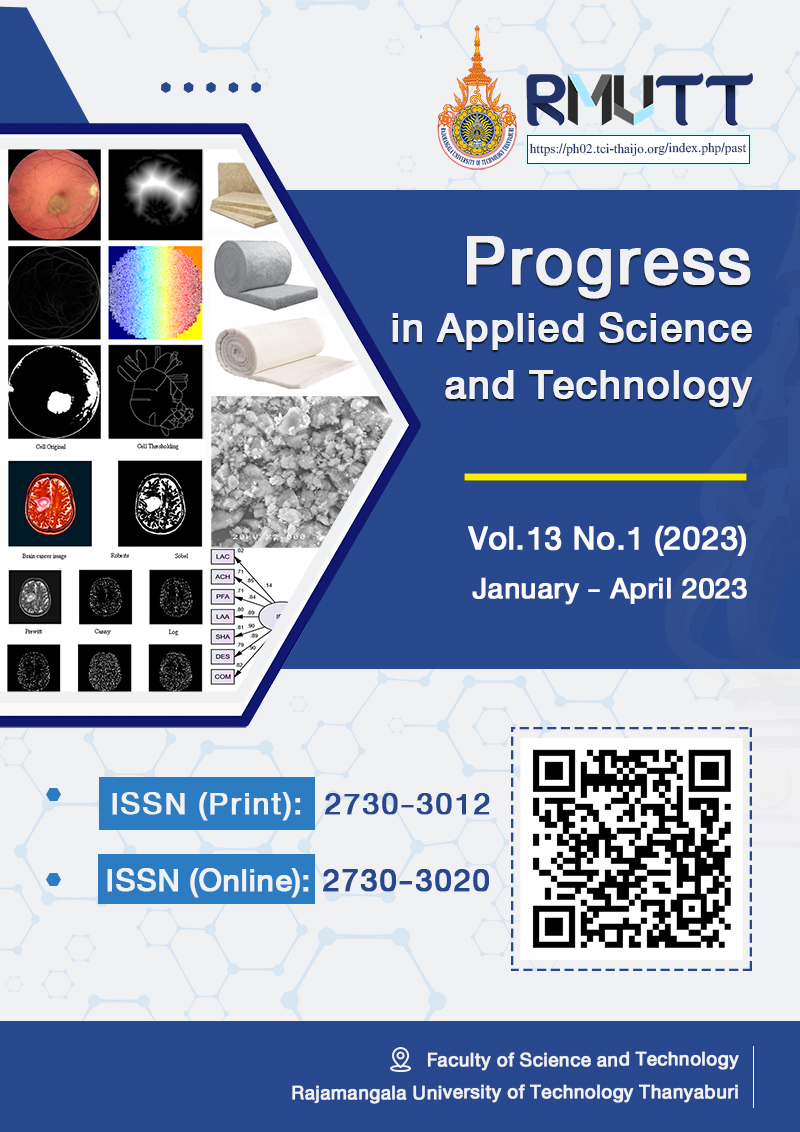The Development of Pigments Reflects Infrared Radiation from Gravel (Lateritic) Soils
Main Article Content
Abstract
This research aims to analyze pigments from lateritic soil to reflect infrared radiation. The lateritic soils used in this research were from Ban Wanghai, Mukdahan Thailand. The study started by analyzing the physical properties and chemical composition of the soil to develop the NIR reflective pigments. The lateritic soils were ground and reduced to sizes smaller than 45 millimeters, then were calcined at 900-1300 for 1 hour. The calcined pigments were characterized and observed by XRD and SEM, and infrared reflection was measured by use of a UV-Vis-NIR spectrophotometer. The results of the research have shown that highly reflective NIR pigments from the soil reflect about 70-80% of infrared radiation at 1000
calcined firing temperature. It was found that quartz and FeAl2O4 were the main constituents. The particle size shows that the highest NIR reflectance is around 1-20 micrometers.
Article Details

This work is licensed under a Creative Commons Attribution-NonCommercial-NoDerivatives 4.0 International License.
References
Papachristou CJ. Introduction to Electromagnetic Theory and the Physics of Conducting Solids: Springer Nature; 2019.
Song D-Y, Sprague R, Macleod HA, Jacobson MR. Progress in the development of a durable silver-based high-reflectance coating for astronomical telescopes. Applied optics. 1985;24(8):1164-1170.
Song, D.-Y.; Sprague, R. W.; Macleod, H. A.; Jacobson, M. R. Appl. Opt. 1985, 24, 1164.
Cho S, Lee MJ, Kim MS, Lee S, Kim YK, Lee DH, et al. Infrared plus visible light and heat from natural sunlight participate in the expression of MMPs and type I procollagen as well as infiltration of inflammatory cell in human skin in vivo. J. Dermatol Sci. 2008;50(2):123-133.
Lee HS, Lee DH, Cho S, Chung JH. Minimal heating dose: a novel biological unit to measure infrared irradiation. Photodermatology, photoimmunology & photomedicine. 2006;22(3):148-152.
Yamada J, Nagahara N, Satoh I, Kurosaki Y. Conductive heat transfer between fluidizing particles and a heat transfer surface in a fluidized bed (visualization of temperature for fluidizing particles). Nihon Kikai Gakkai Ronbunshu, B Hen/Transactions of the Japan Society of Mechanical Engineers, Part B. 2000;66(648):2141-2149. doi: 10.1299/kikaib.66.648_2141.
Muniz FTL, Miranda MR, Morilla dos Santos C, Sasaki JM. The Scherrer equation and the dynamical theory of X-ray diffraction. Acta Crystallographica Section A: Foundations and Advances. 2016;72(3):385-390. doi: 10.1107/S205327331600365X.
Bykova E, Dubrovinsky L, Dubrovinskaia N, Bykov M, McCammon C, Ovsyannikov SV, et al. Structural complexity of simple Fe2O3 at high pressures and temperatures. Nature Communications. 2016;7(1):10661. doi: 10.1038/ncomms10661.
Pati S, Singh LH, Ochoa JM, Guimarãesa E, Sales M, Coaquira J, et al. Facile approach to suppress γ-Fe2O3 to α-Fe2O3 phase transition beyond 600°C in Fe3O4 nanoparticles. Materials Research Express. 2015;2(4):045003. doi: 10.1088/2053-1591/2/ 4/045003.
Soranakom P, Vittayakorn N, Rakkwamsuk P, Supothina S, Seeharaj P. Effect of surfactant concentration on the formation of Fe2O3@SiO2 NIR-reflective red pigments. Ceramics International. 2021;47(9):13147-13155. doi: 10.1016/j.ceramint.2021.01.179.






